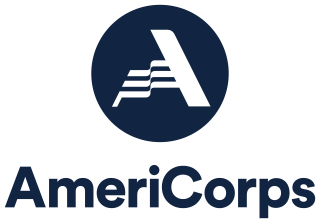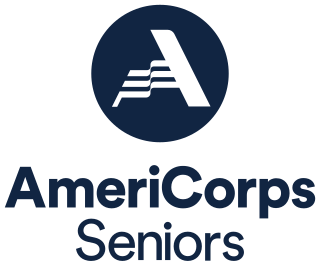
The Civilian Conservation Corps (CCC) was a voluntary government work relief program that ran from 1933 to 1942 in the United States for unemployed, unmarried men ages 18–25 and eventually expanded to ages 17–28. The CCC was a major part of President Franklin D. Roosevelt's New Deal that supplied manual labor jobs related to the conservation and development of natural resources in rural lands owned by federal, state, and local governments. The CCC was designed to supply jobs for young men and to relieve families who had difficulty finding jobs during the Great Depression in the United States. There was eventually a smaller counterpart program for unemployed women called the She-She-She Camps, which were championed by Eleanor Roosevelt.

The Federal Emergency Management Agency (FEMA) is an agency of the United States Department of Homeland Security (DHS), initially created under President Jimmy Carter by Presidential Reorganization Plan No. 3 of 1978 and implemented by two Executive Orders on April 1, 1979. The agency's primary purpose is to coordinate the response to a disaster that has occurred in the United States and that overwhelms the resources of local and state authorities. The governor of the state in which the disaster occurs must declare a state of emergency and formally request from the President that FEMA and the federal government respond to the disaster. The only exception to the state's gubernatorial declaration requirement occurs when an emergency or disaster takes place on federal property or to a federal asset—for example, the 1995 bombing of the Alfred P. Murrah Federal Building in Oklahoma City, Oklahoma, or the Space Shuttle Columbia in the 2003 return-flight disaster.

The Student Conservation Association (SCA) is a non-profit group in the United States whose mission is to build the next generation of conservation leaders and inspire lifelong stewardship of the environment and communities by engaging young people in hands-on service to the land through service opportunities, outdoor skills, and leadership training.
Natural Resources Conservation Service (NRCS), formerly known as the Soil Conservation Service (SCS), is an agency of the United States Department of Agriculture (USDA) that provides technical assistance to farmers and other private landowners and managers.
A corps is a large military unit usually composed of two or more divisions.
The Arab Community Center for Economic and Social Services (ACCESS) is a human services organization committed to the development of the Arab American community. ACCESS helps low-income families, as well as newly arrived immigrants adapt to life in the United States. Its goal is to foster a greater understanding of Arab culture in the U.S. and in the Arab world. ACCESS provides social, mental health, educational, artistic, employment, legal, and medical services.

The National Civilian Community Corps (NCCC), or AmeriCorps NCCC, is an AmeriCorps program founded in 1993 that engages 18- to 26-year-olds in team-based, residential community service projects across the United States. Each year, approximately 2,200 individuals representative of all colors, creeds, states, and economic statuses are chosen to serve in one of four regions covering all 50 states and five territories.
Wild Montana is a grassroots conservation organization founded by a group of Montana outfitters, ranchers, doctors, and friends. The organization is governed by a board of directors from across Montana, working at the local level through seven chapters in Helena, Bozeman, Missoula, Whitefish, Great Falls, Billings, and Butte. Each chapter is governed by a local board of directors. Since 1958, Wild Montana has worked to protect Montana's wilderness, wildlife habitat, and traditional recreation opportunities. The organization was instrumental in the passage of the 1964 Wilderness Act and in the designation of every Wilderness area in the state, like the Bob Marshall, Scapegoat, and Absaroka-Beartooth Wildernesses. It also helped win National Wild and Scenic Rivers System designations for the Missouri and Flathead rivers, and National Monument status for the Upper Missouri River Breaks.

The Washington Conservation Corps (WCC) is a sub-agency of the Washington State Department of Ecology. WCC members work on projects in their communities, from habitat restoration, to trail construction, to natural disaster response. WCC members are active across the state of Washington and are a part of the state and nationwide disaster response network.

Northwest Service Academy (NWSA) was an AmeriCorps program in the Pacific Northwest which focused on environmental service. The program ended in 2010 when the Americorps grant was not renewed. Northwest Service Academy ran from 1994, as an Americorps program in the inaugural year, to 2010.

AmeriCorps is an independent agency of the United States government that engages more than five million Americans in service through a variety of stipended volunteer work programs in many sectors. These programs include AmeriCorps VISTA, AmeriCorps NCCC, AmeriCorps State and National, AmeriCorps Seniors, the Volunteer Generation Fund, and other national service initiatives. The agency's mission is "to improve lives, strengthen communities, and foster civic engagement through service and volunteering." It was created by the National and Community Service Trust Act of 1993. In September 2020, the agency rebranded itself as AmeriCorps, although its official name is unchanged.
The Sierra Nevada Alliance is a network of conservation groups encompassing 24 watersheds of the 650 kilometer-long Sierra Nevada in California and Nevada. Beginning in 1993, the Alliance protects and restores Sierra Nevada lands, watersheds, wildlife and communities.

AmeriCorps Seniors is a United States government program run by the Corporation for National and Community Service. The program engages volunteers aged 55 and older to serve their communities. There are over 200,000 volunteers nationwide.
Rural Action is a non-governmental organization working in Appalachian Ohio promoting economic, social and environmental justice. The organization envisions a region of clean streams, healthy forests, thriving family farms, meaningful jobs for everyone and lively towns that remember local history and celebrate their stories.
CaliforniaVolunteers is the state agency charged with increasing the number and impact of Californians engaged in service and volunteering.

Literacy Volunteers of Illinois (LVI) is a 501(c)(3) nonprofit organization that promotes adult literacy throughout Illinois. It serves families, adults, and out-of-school teens.

The Edward M. Kennedy Serve America Act or Serve America Act was introduced in the United States House of Representatives on March 9, 2009, by Representative Carolyn McCarthy of New York. Originally titled the Generations Invigorating Volunteerism and Education Act, the bill reauthorizes and expands the AmeriCorps program that was first established in 1993. It passed in the House of Representatives on March 18, 2009. The U.S. Senate debated and approved an amended version of the bill on March 26, 2009, renaming it the Edward M. Kennedy Serve America Act, after Senator Ted Kennedy. The House of Representatives voted on the bill a second time, approving the amended version on March 31, 2009. It was signed by President Barack Obama on April 21, 2009.

AmeriCorps VISTA is a national service program designed to alleviate poverty. President John F. Kennedy originated the idea for VISTA, which was founded as Volunteers in Service to America in 1965, and incorporated into the AmeriCorps network of programs in 1993. VISTA is an acronym for Volunteers in Service to America.
The Public Land Corps (PLC) is a work and education program for young people and veterans that is run by the United States land management agencies in association with state conservation and service corps. The objective is the rehabilitation and restoration of public land resources and infrastructure. The Public Land Corps was authorized by the National and Community Service Trust Act on May 27, 1993, H.R. 2328. The 21st Century Conservation Service Corps Act in 2019 allowed Public Land Corps to partner with more federal agencies on conservation and restoration projects and created the Indian Youth Service Corps within the Public Land Corps.
The Serve Illinois Commission on Volunteerism and Community Service is a 40-member, bi-partisan board appointed by the Governor. Its mission is to improve Illinois communities by enhancing traditional volunteer activities and supporting national service programs. The Commission is accomplishing this mission through the support of local community-based efforts to enhance volunteer opportunities and the administration of Illinois' AmeriCorps programs.










